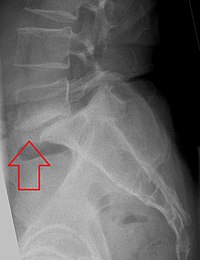
Photo from wikipedia
Study Design Between-session reliability of a magnetic resonance imaging (MRI) based experimental technique to quantify lumbar inter-vertebral motion in humans. Purpose We have developed a novel, dynamic, MRI-based approach for… Click to show full abstract
Study Design Between-session reliability of a magnetic resonance imaging (MRI) based experimental technique to quantify lumbar inter-vertebral motion in humans. Purpose We have developed a novel, dynamic, MRI-based approach for quantifying in vivo lumbar inter-vertebral motion. In this study, we present the protocol’s reliability results to quantify inter-vertebral spine motion. Overview of Literature Morphometric studies on intervertebral displacements using static, supine MRI and quantification of dynamic spine motion using different X-ray based radiography techniques are commonly found in the literature. However, reliability testing of techniques assessing real-time lumbar intervertebral motion using weight-bearing MRI has rarely been reported. Methods Ten adults without a history of back pain performed a side-bending task on two separate occasions, inside an open-MRI, in a weight-bearing, upright position. The images were acquired during the task using a dynamic magnetic resonance (MR) sequence. The MRI imaging space was externally calibrated before the study to recreate the imaging volume for subsequent use in an animation software. The dynamic MR images were processed to create side-bending movement animations in the virtual environment. Participant-specific three-dimensional models were manually superimposed over vertebral image silhouettes in a sequence of image frames, representing the motion trials. Inter-vertebral axes and translation and rotational displacements of vertebrae were quantified using the animation software. Results Quantification of inter-vertebral rotations and translations shows high reliability. Between-session reliability results yielded high values for the intra-class correlation coefficient (0.86–0.93), coefficient of variation (13.3%–16.04%), and Pearson’s correlation coefficients (0.89–0.98). Conclusions This technique may be developed further to improve its speed and accuracy for diagnostic applications, to study in vivo spine stability, and to assess outcomes of surgical and non-surgical interventions applied to manage pathological spine motion.
Journal Title: Asian Spine Journal
Year Published: 2019
Link to full text (if available)
Share on Social Media: Sign Up to like & get
recommendations!